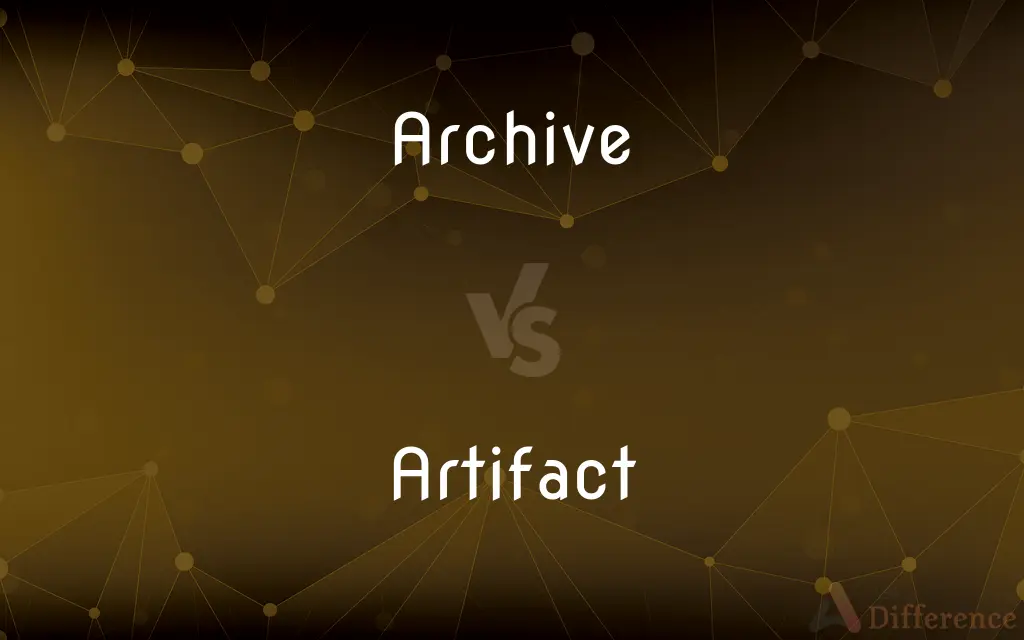Archive vs. Artifact — What's the Difference?
By Tayyaba Rehman & Urooj Arif — Updated on April 26, 2024
Archives are collections of records preserved for their historical value, whereas artifacts are physical objects from the past, significant due to their historical context.

Difference Between Archive and Artifact
Table of Contents
ADVERTISEMENT
Key Differences
An archive typically refers to a collection of documents, recordings, and other media that are stored and preserved due to their informational and historical value. On the other hand, an artifact is a physical object made, modified, or used by humans, often unearthed during archaeological excavations.
Archives are usually managed by institutions like libraries, universities, or government bodies, focusing on the systematic preservation and organization of documents. In contrast, artifacts are often found in museums or archaeological sites, highlighting cultural and historical insights.
The purpose of an archive is to preserve records for future reference and research, providing a continuous account of an organization's or individual's history. Whereas artifacts serve as tangible evidence of past human activities, offering direct insights into historical lifestyles, technologies, and cultures.
Archives often include items such as letters, reports, minutes of meetings, and photographs, all primarily paper-based or digital. Conversely, artifacts can range from pottery and tools to bones and buildings, encompassing a wide variety of materials.
The methods of preservation also differ; archives require controlled environments to prevent decay of paper and digital formats, while artifacts may need conservation techniques to restore and maintain physical objects.
ADVERTISEMENT
Comparison Chart
Definition
A collection of historical documents or records.
A physical object made or used by humans in the past.
Location
Typically housed in libraries, universities.
Often found in museums, archaeological sites.
Purpose
To preserve historical data and records for research.
To provide physical evidence of historical human life.
Types of Materials
Paper documents, digital files.
Pottery, tools, textiles, bones.
Preservation Methods
Controlled environments, digitization.
Restoration, physical conservation.
Compare with Definitions
Archive
A place where public records or historical documents are kept.
The National Archives stores pivotal government documents.
Artifact
Any object made or modified by humans, generally an ancient tool or piece of art.
The museum displayed artifacts from the Bronze Age.
Archive
The collection of records preserved for their historical value.
The university’s archive has a rich collection of medieval manuscripts.
Artifact
Something viewed as a product of human art and workmanship.
This vase is more than a container; it’s a cultural artifact.
Archive
To store digital information or documents in a long-term storage solution.
We archive all our emails for compliance reasons.
Artifact
An object remaining from a particular period.
Each artifact at the site gives a clue about the past civilizations.
Archive
A repository for data stored in a non-active form.
The company archives old projects to free up space on their servers.
Artifact
An item that archaeologists recover during excavations.
The newly discovered artifact could tell much about the early settlers.
Archive
The act of transferring data to a storage device for preservation.
Archiving data regularly can prevent data loss.
Artifact
An item that helps in understanding historical events.
Artifacts from the war front help historians piece together battles.
Archive
An archive is an accumulation of historical records – in any media – or the physical facility in which they are located. Archives contain primary source documents that have accumulated over the course of an individual or organization's lifetime, and are kept to show the function of that person or organization.
Artifact
Something viewed as a product of human conception or agency rather than an inherent element
"Morality is an artifact of human culture, devised to help us negotiate social relations" (Michael Pollan).
Archive
Often archives A place or collection containing records, documents, or other materials of historical interest
Old land deeds in the municipal archives.
Artifact
An object produced or shaped by human craft, especially a tool, weapon, or ornament of archaeological or historical interest.
Archive
A long-term storage area, often on magnetic tape, for backup copies of files or for files that are no longer in active use.
Artifact
A phenomenon or feature not originally present or expected and caused by an interfering external agent, action, or process, as an unwanted feature in a microscopic specimen after fixation, in a digitally reproduced image, or in a digital audio recording.
Archive
A file containing one or more files in compressed format for more efficient storage and transfer.
Artifact
An inaccurate observation, effect, or result, especially one resulting from the technology used in scientific investigation or from experimental error
The apparent pattern in the data was an artifact of the collection method.
Archive
A repository for stored memories or information
The archive of the mind.
Artifact
An object made or shaped by human hand or labor.
Archive
To place or store in an archive.
Artifact
An object made or shaped by some agent or intelligence, not necessarily of direct human origin.
Archive
(Computers) To copy or compress (a file) into an archive.
Artifact
Something viewed as a product of human agency or conception rather than an inherent element.
Archive
A place for storing earlier, and often historical, material. An archive usually contains documents (letters, records, newspapers, etc.) or other types of media kept for historical interest.
Artifact
A finding or structure in an experiment or investigation that is not a true feature of the object under observation, but is a result of external action, the test arrangement, or an experimental error.
The spot on his lung turned out to be an artifact of the X-ray process.
Archive
The material so kept, considered as a whole (compare archives).
His archive of Old High German texts is the most extensive in Britain.
Artifact
(archaeology) An object, such as a tool, ornament, or weapon of archaeological or historical interest, especially such an object found at an archaeological excavation.
The dig produced many Roman artifacts.
Archive
(ecology) Natural deposits of material, regarded as a record of environmental changes over time.
Soil archive
Peat archive
Artifact
(biology) An appearance or structure in protoplasm due to death, the method of preparation of specimens, or the use of reagents, and not present during life.
Archive
(transitive) To put (something) into an archive.
I was planning on archiving the documents from 2001.
Artifact
(computing) A perceptible distortion that appears in an audio or video file or a digital image as a result of applying a lossy compression or other inexact processing algorithm.
This JPEG image has been so highly compressed that it has unsightly artifacts, making it unsuitable for the cover of our magazine.
Archive
The place in which public records or historic documents are kept.
Our words . . . . become records in God's court, and are laid up in his archives as witnesses.
Artifact
(museology) Any object in the collection of a museum. May be used sensu stricto only for human-made objects, or may include ones that are not human-made.
Archive
Public records or documents preserved as evidence of facts; as, the archives of a country or family.
Some rotten archive, rummaged out of some seldom explored press.
Artifact
A product of human workmanship; - applied esp. to the simpler products of aboriginal art as distinguished from natural objects.
Archive
A depository containing historical records and documents
Artifact
Any product of human workmanship; - applied both to objects made for practical purposes as well as works of art. It is contrasted to natural object, i.e. anything produced by natural forces without the intervention of man.
Archive
Put into an archive
Artifact
A structure or appearance in protoplasm due to death, method of preparation of specimens, or the use of reagents, and not present during life.
Artifact
An object, oservation, phenomenon, or result arising from hidden or unexpected causes extraneous to the subject of a study, and therefore spurious and having potential to lead one to an erroneous conclusion, or to invalidate the study. In experimental science, artifacts may arise due to inadvertant contamination of equipment, faulty experimental design or faulty analysis, or unexpected effects of agencies not known to affect the system under study.
Artifact
A man-made object taken as a whole
Common Curiosities
What is an artifact?
An artifact is a physical object made or used by humans, often of historical or cultural interest.
How are archives preserved?
Archives are preserved through controlled environments and, if digital, through regular backups.
What types of materials can be found in an archive?
Archives typically contain paper-based documents, photographs, and increasingly, digital files.
How do artifacts come to be in museums?
Artifacts are often placed in museums after being discovered during archaeological digs.
Can an artifact be something other than an ancient object?
Yes, artifacts can also be more recent items if they are of cultural or historical significance.
What is an archive?
An archive is a collection of records preserved for historical or informational purposes.
What is the difference between an archive and a library?
An archive is specifically for preserving historical documents, whereas a library provides broader access to books and information.
Can digital items be considered artifacts?
Yes, digital artifacts include software, websites, and digital images that are culturally significant.
Are archives open to the public?
Many archives are open to the public, though some may have restrictions on access.
Why is it important to preserve archives?
Preserving archives ensures that future generations have access to historical records.
How do artifacts help us understand history?
Artifacts provide tangible evidence of past societies and their ways of life.
What does it mean to archive information?
Archiving information means storing it in a way that ensures its long-term preservation and accessibility.
What are some examples of artifacts?
Examples include tools, jewelry, pottery, and clothing from different historical periods.
Who manages archives and artifacts?
Professionals such as archivists and curators manage archives and artifacts, respectively.
What techniques are used to preserve artifacts?
Techniques include chemical treatments, controlled environments, and careful physical restoration.
Share Your Discovery

Previous Comparison
Inventory vs. Assets
Next Comparison
Order vs. RegularityAuthor Spotlight
Written by
Tayyaba RehmanTayyaba Rehman is a distinguished writer, currently serving as a primary contributor to askdifference.com. As a researcher in semantics and etymology, Tayyaba's passion for the complexity of languages and their distinctions has found a perfect home on the platform. Tayyaba delves into the intricacies of language, distinguishing between commonly confused words and phrases, thereby providing clarity for readers worldwide.
Co-written by
Urooj ArifUrooj is a skilled content writer at Ask Difference, known for her exceptional ability to simplify complex topics into engaging and informative content. With a passion for research and a flair for clear, concise writing, she consistently delivers articles that resonate with our diverse audience.














































